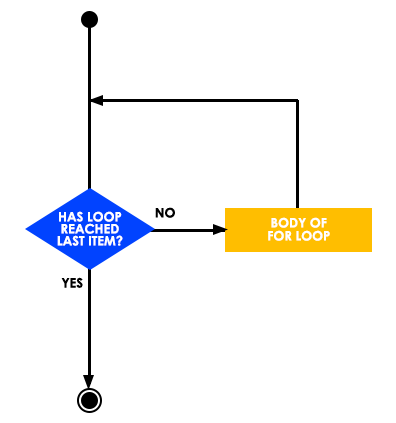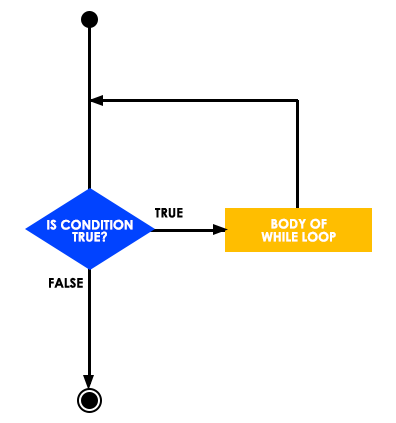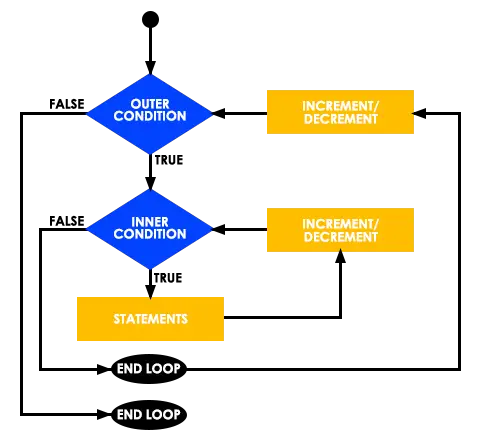What are Loops in Python?
- Loops are used to do the same thing over and over until a certain condition is met.
- Loops are programming constructs that allow you to repeatedly execute a block of code based on a certain condition.
- Loops are used to automate repetitive tasks and iterate over collections of data.
The diagram below is the structure of a loop statement:
Why do we use Loop in Python?
The reason why we use loops in Python is that loops are essential in any programming language since they allow you to repeatedly execute a section of code.
You will frequently encounter circumstances in which you need to reuse a piece of code, but you do not want to write the same line of code many times.
Types of Loops in Python
The following is a list of the different types of loops in Python:
- For Loops
- While Loops
- Nested Loops
1. For Loops in Python
For Loops in Python iterates over a series (list, tuple, set, dictionary, and string).
This is more like the iterator function in other object-oriented programming languages than the for keyword in other languages.
Syntax
The following code below is the for loops syntax in Python:
for iterating_var in sequence:
#execute your codeFlow Diagram
Below is the for loops flow diagram:
Examples
Here are some of for loops examples:
months = ["Jan", "Feb", "Mar"]
for a in months:
print(a)You can test the above example here! ➡Python Online Compiler
Output:
Jan
Feb
MarThe for loop doesn’t need you to set up an indexing variable first.
Even strings, which are made up of a series of characters, are iterable objects.
for a in "itsourcecode":
print(a)Output:
i
t
s
o
u
r
c
e
c
o
d
eElse Statements in For Loops
Like if statements, a for loop can have an optional else statement block. If there are no more items in the order used in the for loop, the else part is executed.
A for loop can be stopped with the break keyword. When this happens, the else part is ignored.
So, the else part of a for loop runs if there is no break.
Example:
count = [5, 4, 3, 2, 1]
for i in count:
print(i)
else:
print("No items left.")You can test the above example here! ➡Python Online Compiler
Output:
5
4
3
2
1
No items left.2. While Loops in Python
A while loop statement in Python programming runs a target statement over and over as long as a given condition is true.
Most of the time, we use this loop when we don’t know ahead of time how many times to iterate.
Syntax:
The following code below is the while loops syntax in Python:
while expression:
#execute your codeFlow Diagram
Below is the while loops flow diagram:
Examples
Here is a while loop example:
i = 1
while i < 11:
print(i)
i += 1You can test the above example here! ➡Python Online Compiler
Output:
1
2
3
4
5
6
7
8
9
10Don’t forget to increment i or the loop will keep going forever.
In order to use the while loop, the right variables must be ready. In this case, we need to define an indexing variable i and set it to 1.
Else Statement in While Loops
We can also use the else statement in while loops in Python just like in for loops.A break statement can be used to end the while loop.
In these situations, the else part is ignored. So, the else statements part of a while loop runs if the condition is false and there is no break.
Example:
count = 0
while count < 5:
print (count, " is less than 5")
count = count + 1
else:
print (count, " is not less than 5")You can test the above example here! ➡Python Online Compiler
Output:
0 is less than 5
1 is less than 5
2 is less than 5
3 is less than 5
4 is less than 5
5 is not less than 53. Nested Loops in Python
A nested loop in Python is a loop that is inside the body of another loop. This means that every time the “outer loop” is run, the “inner loop” will be run once.
Syntax:
Below is the nested loop syntax in Python:
for iterating_var in sequence:
for iterating_var in sequence:
#execute your code
#execute your codeFlow Diagram
The following figure below is the nested loop flow diagram.
Example
Below is the Nested Loops Example in Python:
color = ["red", "blue", "yellow"]
thing = ["cellphone", "laptop", "shoe"]
for a in color:
for b in thing:
print(a, b)You can test the above example here! ➡Python Online Compiler
Output:
red cellphone
red laptop
red shoe
blue cellphone
blue laptop
blue shoe
yellow cellphone
yellow laptop
yellow shoeLoop Control Statements in Python
Loop Control Statements in Python are used to alter the execution flow. These may be used to skip an iteration or terminate the process.
Types of Loop Control Statements
Below are the different types of loop control statements in Python:
- Break Statement
- Continue Statement
- Pass Statement
1. Break Statement
The break statement halts execution and exits the loop, depending on the specified circumstance,
Example: Make a list of odd numbers between 1 and 20. (use while, break)
num = 1
odd_nums = []
while num:
if num % 2 != 0:
odd_nums.append(num)
if num >=20:
break
num += 1
print("Odd numbers: ", odd_nums)You can test the above example here! ➡Python Online Compiler
Output:
Odd numbers: [1, 3, 5, 7, 9, 11, 13, 15, 17, 19]2. Continue Statement
The continue statement skips the current iteration and lets the loop move on to the next one when the condition is met.
It doesn’t take control out of the loop unless you put the break statement outside of the loop.
Example: If the current number is 6, skip the iteration (use while,continue)
num = 0
while num < 10:
num += 1
if num == 6:
continue
print(num)You can test the above example here! ➡Python Online Compiler
Output:
1
2
3
4
5
7
8
9
103. Pass Statement
The pass statement is used in Python when a statement is required syntactically but no command or code is to be run.
It doesn’t skip over or stop the execution. Instead, it moves on to the next iteration.
It’s useful when we don’t want to write code right now but want to add functionality later.
Example:
#while loop pass statement
print("While loop Pass Statement\n")
num = 1
while num <= 10:
if num == 6:
pass
print(num)
num += 1
print("\nFor loop Pass Statement\n")
#for loop pass statement
for num in range(1, 11):
if num == 6:
pass
print(num)You can test the above example here! ➡Python Online Compiler
Output:
While loop Pass Statement
1
2
3
4
5
6
7
8
9
10
For loop Pass Statement
1
2
3
4
5
6
7
8
9
10Summary
To conclude, this article provides a comprehensive overview of loops in Python.
It covers the concept of loops, their purpose in programming, and their ability to automate repetitive tasks.
The article explores three types of loops: for loops, while loops, and nested loops.
Python Decision Making
Python Numbers





